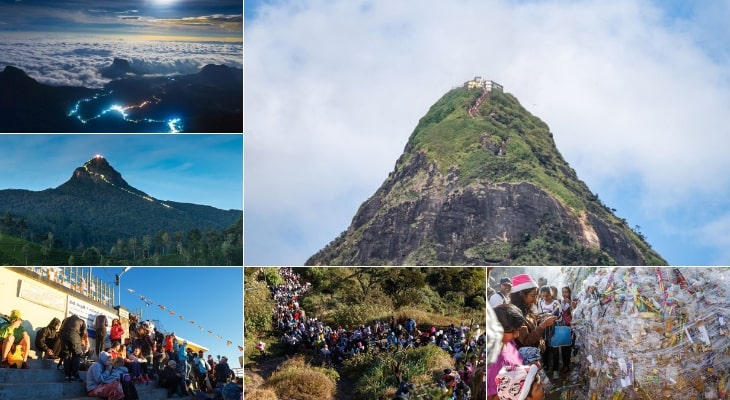
Adam’s Peak Sri Lanka is the most famous and most-visited mountain among all the mountains and peaks located in the country. This picturesque conical shaped mountain towers above its surrounding hills in the Sabaragamuwa province of Sri Lanka, which is the southwestern corner of the country’s highlands.
Ratnapura and Hatton are the closest towns to the mountain and it is situated 40 kilometers and 32 kilometers away from these towns respectively. Adam’s Peak Sri Lanka stands out from its surrounding mountains because of its perfect conical shape and the lush rain forest that covers it.
It is the 4th highest mountain in Sri Lanka stands at a maximum altitude of 2,243 meters above sea level. The lower slopes of the mountain are the source of all the four main rivers in the country, hence the part it plays in the biodiversity of the island is colossal.
Along with the rain forest that covers Adam’s Peak, the surrounded forest area is considered to be a protected wildlife reserve.
The forest is home to many mammals such as the occasional elephant, leopards, many types of wild cats as well as many types of small deer. The colossal trees are home to many species of birds, some of which are endemic to Sri Lanka. Adam’s Peak is not your average steep mountain which provides an adventurous hike to the mountain-climbing enthusiast.
While it certainly is the most distinguish conical shaped mountain you will see on your visit to Sri Lanka, there is no other mountain in the world which is more worshipped by devotees of various religions than Adam’s Peak.
Buddhists, Hindus, Muslims and Christians believe that the relic at the summit of the mountain holds an astounding significance to their particular religions. Every year, thousands of devotees of all these religions climb to the summit of Adam’s Peak to pay homage to the relic.
Religious Significance of Sri Pada
As all the photographs of Adam’s Peak Sri Lanka suggest, it is one of the most impressive conical shaped mountains you will meet on your travels around the world. The fact that the forest covering the mountain is a protected nature reserve only adds to its significance but these are not the facts which makes it worshipped by devotees of various religions.
The most significant and famous fact about Adam’s Peak Sri Lanka is that it contains an indentation shaped like a foot at the top of the mountain on the rocky summit. This indentation is the fact that Adam’s Peak is considered sacred in multiple religions of the world. The story behind the foot-shaped indentation varies from religion to religion and based on whom you ask, the legends change. Following are the most common beliefs of each religion.
Since the population of Sri Lanka consists of mostly Sinhalese Buddhists, the most common belief is that the sacred footprint on top of Adam’s Peak belongs to Lord Buddha, which was set on the summit by the invitation of the local deity ‘Saman’ on his third visit to Sri Lanka.
Tamil Hindus of Sri Lanka and India believe that the footprint at the top of the sacred mountain is to of God Shiva’s. South Indian inscription, ‘Ramayana’ also suggests that the Adam’s Peak Sri Lanka is the legendry mountain ‘Trikuta’, the capital of the ancient Sri Lankan king Ravana from when he ruled the country.
Muslims and Christians believe the footprint to belong to their forefather, or the primordial human, Adam, set on the top of the mountain as he was exiled from the Garden of Eden.
This connection of Adam to the mountain has also led to the idea that Sri Lanka was the original Garden of Eden itself. During the Portuguese rule of the country, Portuguese Christians have had many beliefs when it came to the owner of the footprint on top of the sacred mountain.
While some believed it to be Adam’s, some believed it belonged to St. Thomas, the disciple of Jesus, or even to the Queen of the Ethiopians. A Chinese inscription which belongs to the 15th century suggests that the footprint belongs to Pwan-Ko, the first man to exist in Chinese mythology.
Reinforcing all the beliefs of every devotee of every religion, Adam’s Peak Sri Lanka displays some of the most enchanting and unusual optical illusions one can see in a lifetime, which has effortlessly fueled the idea that the mountain is no ordinary place. One such optical illusion is the appearance of several illusions of the sun, before the sun itself is risen. It happens due to the reflection of light when entering air atmospheres of different densities.
It is described in physics as ‘total internal light reflection’ and when viewed from the top of the Adam’s Peak Sri Lanka, the pilgrims believe it to be the sun paying homage to the sacred footprint multiple times before actually rising. Another one of the enchanting sights the pilgrims thrive to catch from the top of Adam’s Peak Sri Lanka is the perfectly symmetrical conical-shaped shadow which seems to hang from mid-air at the sunrise.
All these phenomena have scientific explanations, but that does not change the fact that nearly 20,000 religious devotees climb to the summit of Adams Peak to worship the sacred footprint. Pilgrim’s interpretations of these illusions are truly worthy to hear and it can amaze oneself on the depth of religious beliefs and myths.
History of Sri Pada | Adam’s Peak Footprint
There are many historical records that tell us of Adam’s Peak Sri Lanka and the first one of them is found in the earliest Pali chronicle, ‘Deepawamsa’ in the 4th century. The 5th century ‘Mahawamsa’ is where it stated that Lord Buddha visited the mountain peak to set his footprint on the rocky summit.
The sacred footprint is believed to be discovered by King Valagambahu of the 1st century BCE and brought to the light of the Buddhists. The king was in hiding from the South Indian invaders and local legends tell that the local deity ‘Saman’ led him to the footprint disguised as a stag. The many historical records by various travelers from all over the world state that Adam’s Peak was visited by thousands of religious devotees throughout centuries.
The fact that Sri Lanka is positioned in the main sea route that linked the ancient eastern world to the western world (silk route), is considered to be one of the main reasons that the mountain was able to attract pilgrims from around the world.
Many inscriptions reveal that Adam’s Peak was visited by many Chinese, Arabic, Indian monks from 300-500 CE for at least a thousand years. It is found in inscriptions that Ibn Battuta, a famous Moroccan explorer climbed the sacred mountain in 1344 CE. In his records, he has said that the Adam’s Peak Sri Lanka could be seen from the sea even if his ship was nine days away from the island, which is about 80 miles before the coastline came into view.
Even though the famous Venetian traveling merchant, Marco Polo did not climb Adam’s Peak Sri Lanka on his visit to the island, he mentions it in one of his records. He claims that ascension to the top of Adam’s Peak was almost impossible, if not for the iron chairs which were built to aid the climbing process.
Sinhalese kings, all the way from the Polonnaruwa kingdom to the Kandyan dynasty, have regarded the Adam’s Peak Sri Lanka with royalty, set on their Buddhist beliefs. According to the records of Marco Polo, a Sinhalese king had built steps and iron chairs to ease the climb of the devotees.
It is said that this climb to the top of Adam’s Peak was so challenging and fatal during ancient times, that the religious devotees who plan on making the climb even passed on their houses, lands and other properties to their next of kin before beginning the ascension.
Seeing the many difficulties faced by the pilgrims on the tough climb to the summit of Adam’s Peak, ancient kings have built steps, shelters and hand railings to facilitate the devotees. Some kings have even allocated entire villages to accommodate the pilgrims on their journey to the top of the sacred mountain.
Adam’s Peak Sri Lanka was considered royalty since ancient times. Even the Nayyakkar kings of the Kandyan dynasty paid homage to the sacred mountain, as it was believed to be a place of miracles and had a great impact on the peace and prosperity of the country.
The Many Names of Sri Pada | Adam’s Peak and Why?
It is no wonder that Adam’s Peak has many names given its history, beliefs and the diversity of the people associated with it. Prior to the arrival of Buddhism in Sri Lanka, the mountain was said to be the home of the local deity ‘Saman’ or ‘Samanta’, hence it was called ‘Samantakuta’, which basically translates into ‘Peak of Saman’ or ‘Samanta’s Abode’. Adam’s Peak is mentioned in this name in the Mahavamsa also, which was said to be chronicled in the 5th century CE.
‘Sri Pada’ is the most commonly referred name to the Adam’s Peak Sri Lanka nowadays among the Sinhalese of the country, which translates in to ‘Sacred Foot’ in Sanskrit. In Sinhala, the mountain is also referred to as ‘Samanala Kanda’ which basically translates into the hill of butterflies.
This is a very fitting name as thousands of butterflies frequent the colossal mountain during their migration to the area. Adam’s Peak is also called ‘Ratnagiri’, in which ‘ratna’ means precious gems and ‘giri’ means hill. ‘Ratnagiri’ basically means the jeweled hill, and this comes as no surprise since the area the mountain is in is famous for precious gems.
South Indian Hindus refer to the mountain as ‘Svargarohanam’ which means the ascension to heaven or ‘Shiva Padam’, meaning Shiva’s Foot. The English name of the mountain, ‘Adam’s Peak’ is derived from the Christian belief of the footprint to be of Adam’s and it is the most commonly recognized name for the mountain around the world.
The Portuguese also claim the mountain as Pico de Adam and in Sanskrit literary texts, the mountain is referred to by many names, including Mount Lanka, Malayagiri and Mount Rohana.
The Summit and the Sacred Footprint
The summit of Adam’s Peak Sri Lanka is 2,243 meters above sea level and it is the location of the foot-shaped indentation on the rocky surface. On the summit, there is a resting place built for the pilgrims as well as a shrine and a belfry.
The actual foot-shaped indentation cannot be seen as it is covered by a huge stone tablet shaped like a foot, carved with many religious symbols. This is the sacred monument thousands of pilgrims travel to pay homage to, as well as in the hopes of witnessing the enchanting sunrise and the shadow of the mountain.
Many seafarers, explorers and reputed Englishmen such as Giovani de Marigolli, Robert Knox, Captain John Ribeyro and James Emerson Tennent who visited Adam’s Peak Sri Lanka, have claimed the relic to be of different sizes, ranging from 2 feet to 5 feet. However, while no one knows the actual size of the sacred footprint, the carved stone tablet that covers it today is about 6 feet in length.
The summit of Adam’s Peak Sri Lanka is 2,243 meters above sea level and it is the location of the foot-shaped indentation on the rocky surface. On the summit, there is a resting place built for the pilgrims as well as a shrine and a belfry.
The actual foot-shaped indentation cannot be seen as it is covered by a huge stone tablet shaped like a foot, carved with many religious symbols. This is the sacred monument thousands of pilgrims travel to pay homage to, as well as in the hopes of witnessing the enchanting sunrise and the shadow of the mountain.
Many seafarers, explorers and reputed Englishmen such as Giovani de Marigolli, Robert Knox, Captain John Ribeyro and James Emerson Tennent who visited Adam’s Peak Sri Lanka, have claimed the relic to be of different sizes, ranging from 2 feet to 5 feet. However, while no one knows the actual size of the sacred footprint, the carved stone tablet that covers it today is about 6 feet in length.
Peak Wilderness Sanctuary
Peak Wilderness Sanctuary is the lush forest that covers Adam’s Peak Sri Lanka, along with its neighboring peaks such as Detanagala, Bena Samanala and Dotalugala. It is one of the 50 nature sanctuaries in the country and spreading over 224 square kilometers, it is also the third-largest sanctuary in Sri Lanka.
Peak Wilderness Sanctuary was declared as a wildlife sanctuary on 25th October 1940, but that was only the remaining portion of the rain forest after a large area was cleared during the British colonial rule in Sri Lanka to obtain lands for tea plantations. Even today, these plantations are functioning in the Nuwara Eliya district, and they also serve as borders to the Peak Wilderness Sanctuary. The eastern boundary of the forest connects to the Pidurutalagala mountain range.
The rich tropical rain forest of the Peak Wilderness Sanctuary spreads from 1,000 to 7,360 feet above sea level and because of this sharp geographical ascension, it possesses an unusual biodiversity which cannot be witnessed in other national parks in Sri Lanka.
While Adam’s Peak Sri Lanka is the tallest mountain in the region, many other hills also sprout up from within the wilderness. Peak Wilderness Sanctuary is rich in water bodies because of the abundant rains that fall in the region. It is the source of all the main rivers in the country such as Kelani river, Kalu river and Walave river, while also being home to a number of waterfalls Galagama falls, Dotalu falls and Geradi falls.
The sanctuary is a biodiversity hotspot with a wide range of animals and plants making it their home. The only few elephants in the wet zone of Sri Lanka are found here along with a considerable number of leopards, including extremely rare black leopards.
Many other smaller mammals frequent the lush greenery such as small deer species and wild cats. These species are Mouse deer, Jungle cat, Fishing cat, Rusty-spotted cat and Barking deer. Due to the frequent rainfall and the large number of water bodies, amphibians and fish are rich in the water streams. Some of the world’s rarest toad species are said to be found in Peak Wilderness Sanctuary.
The avifauna of the forest is also wide and magnificent, with colourful, rare and endemic birds making the forest their permanent habitat. Out of the six access routes that people use to climb the Adam’s Peak Sri Lanka, two of them; Kuruwita route and Palabaddala route are laid through the Peak Wilderness Sanctuary.
However, there are no bungalows, lodges, or any type of accommodation options within the sanctuary to preserve the biodiversity and the purity of the rainforest. The necessary caution protocols are always maintained and practiced by the Sri Lanka Wildlife Conservation Department. However, eco-tourists are allowed to enter the sanctuary after getting permission from the relevant governing bodies.
Routes to the Summit
Although there was only one route through the area of Ratnapura to climb Adam’s Peak during ancient times, now there are 6 routes to reach the summit of the mountain. These are more like starting points rather than routes and namely, they are Hatton-Nallathanniya, Murraywatte, Ratnapura-Palabaddala, Mookaywatte, Kuruwita-Erathna and Malimboda.
Even though there are a lot of starting points to start the hike, some of these nodes are rarely used. The rest also varies in popularity and the most commonly used starting point is the Hatton-Nallathanniya point which starts from the tiny village of Nallathanniya.
This route is actually shorter than all the other routes by nearly 5 kilometers, but it is the steepest one of the lot. Ratnapura-Palabaddala is the second most sought-after trail to reach the summit of Adam’s Peak Sri Lanka and usually, the most adventurous hikers tend to choose this route.
However, climbing up from the Nallathanniya trail and descending from the Palabaddala trail is also a common option among the pilgrims since the steepest trail of Nallathanniya can prove to be difficult to descend than ascend.
The Best Route and How to Get There
Because the most popular route to ascend to the summit of Adam’s Peak Sri Lanka is the Hatton-Nallathanniya route, we have chosen to bring more information about it to the traveler and the pilgrim who are looking to make the climb to the top of the mountain.
Nallathanniya is also referred to as Dalhousie and Hatton is the closest large town to it. Hatton can be easily reached by train from Colombo, Kandy, or even from Ella, since the train is the cheapest transportation option in Sri Lanka. Although Sri Lankan trains can be pretty crowded, the train routes are breathtakingly beautiful, so it would be a treat to take the train.
Hiring a private vehicle from the main cities of Colombo, Kandy or Ella is also possible at a higher cost, but the journey will be quicker and more comfortable as opposed to public transportation options. Once you reach Hatton by train, you can catch a bus to Dalhousie via Maskeliya without a problem. The route to Dalhousie from Hatton is extremely scenic and the bus ride takes around one and half hours at 0.60 USD approximately.
Tuk tuks are also available to get to Dalhousie and it will take around one hour at 7-11 USD. The total distance from Hatton to Dalhousie is about 32 kilometers. There are approximately 7 kilometers to the summit of Adam’s Peak from the village of Dalhousie with an elevation of 1,000 vertical meters. The trailhead stands at 1,252 meters above sea level and ascends towards 2,243 meters at the top of the mountain.
The ascension to the summit of the sacred mountain takes around 3-7 hours depending on the fitness level of the climber. The climb actually begins very gradually at the start and this gradually inclining part of the trail is lined with small shops, massage parlours, tea houses and small shrines.
The actual beginning of the trails is marked with a beautifully carved stone archway, which is called ‘Makhura Gateway’. The carvings are related to Hindu mythology, including elephants and other mythological creatures with a vicious looking jawless monster at the top. The trail afterward is lined with a tree plantation on one side and on the other side, beautiful sceneries can be seen, including several small waterfalls down a huge rock.
On the hike to Adam’s Peak Sri Lanka, one of the Japanese peace pagodas on the island can be found and it is called ‘Sama Chetiya’. It was built in 1976 by Ven Nichi Fuji, a famous Japanese monk. The pagoda is found 2 kilometers into the hike.
Onwards from Sama Chetiya, the hiking trail is laid through the lush greenery of the Peak Wilderness Sanctuary. Here is where the hike starts to get steeper, and there are several resting stops along the way, especially a small stream called ‘Seetha Gangula’ where the pilgrims make it customary to wash their faces and refresh themselves.
Further upwards on the trail, it suddenly becomes very steep from a point locals refer to as ‘Indikatupana’. From here, locals call the area ‘Mahagiridamba’, which basically translates into ‘the great rock climb’ and it continues all the way to the summit of the mountain.
The Best Time to Climb Sri Pada | Adam’s Peak
The official pilgrimage season of Adam’s Peak Sri Lanka is from December to May every year. To be more precise, the season starts from the full moon Poya day of December to the full moon Poya day of May next year. These two Poya days are called ‘Unduwap’ and ‘Vesak’ respectively and they play a major role in the Sri Lankan Buddhist culture.
However, during the pilgrimage season, the hiking trail is packed with religious devotees of all kinds and it is almost impossible to experience the natural beauty of the area. Weekends and Sri Lankan Poya days are jam-packed with pilgrims, hence you might need to avoid these days when climbing.
It is also advised to avoid the Sri Lankan New Year time (first two weeks of April every year) because the queues are so long that some people even give up the climb before reaching the summit.
During the time outside the pilgrimage season, climbing conditions are less favourable because of the heavy rains and wild animals roaming freely in the area. However, it becomes a more challenging experience to the adventure-seeker, so climbing Adam’s Peak in the off-season will be at your own risk.
What You Should Know Before you climb?
Before you decide to climb up Adam’s Peak Sri Lanka, you need to be aware of all facts that are likely to be a concern during the hike. Either you climb for the scenic adventure it offers or for religious purposes, there are a few factors that need to be taken into consideration.
When it comes to accommodation in the Dalhousie area to facilitate your hike, there are a lot of options ranging from budget to medium class. However, during the pilgrimage season, the prices of almost every accommodation place skyrocket and it will be pretty hard to find a place to stay unless you book one in advance.
As expected, during the off-season, the prices are very low and you wouldn’t have to make a booking in advance either. During the hike, which is the main part of the journey, there are numerous factors to pay attention to. Even though the weather during pilgrimage season is said to be mild and perfect for climbing, in this part of the country, it can change within a few minutes. So be prepared for anything that might come your way; either the scorching sun, strong winds, or heavy rains.
Traditionally, the ascension to the summit of the sacred mountain is done during the night around 1-2 AM, so that the pilgrims are able to catch the breathtaking sunrise from the top.
Hence, if you are also planning to keep to the tradition, make sure you take a lot of warm clothes with you as the summit can be freezingly cold until the sun comes up. Even if you climb during the day, the morning hours after 8 in the morning can be warm or hot, but as soon as the sun turns, it may start to get colder and colder by the minute.
No matter how fit you are, it is wise to carry trekking poles with you because when you are close to the summit, your knees will be screaming as 5,500 steps which get steeper and steeper near the top is no joke. However, you won’t be needing any special hiking shoes because the entire trail is covered with concrete steps, and some devotees even climb barefoot all the way to the top.
Climbing the mountain during the off-season is even more challenging as heavy rains can be expected at any time of the day, and the stairs can be overflowing with water, making them extremely slippery. Also unlike in the pilgrimage season, the foliage on the sides of the steps is not cleared, so leeches can be a problem when climbing in the off-season.
To ward off leeches, you can either apply a citronella-based balm on the lower parts of your legs as the strong citronella smell keeps the pesky creatures at bay. Also, carry a small tub of salt with you to apply if a leech actually gets on to your foot.
You can also wear long clothes and tuck the pant-ends into your socks so that leeches cannot reach. Tobacco is also an effective deterrent against leeches and you can always find special leech socks in Sri Lanka if you are planning to do some serious rain forest trekking.
The hike up and down the mountain will take about 7 hours approximately, so make sure that you carry your own water, food and other personal products you may need, even though there are plenty of small shops along the trail.
If you are having physical disabilities or a sport injury of any kind, always think twice about making the climb because it can prove to be very challenging from a certain point upwards and downwards as the steps are very steep at some locations.
In conclusion, the hike up to the summit of Adam’s Peak is a moderately challenging one adorned with scenic beauty and surrounded by a lush rain forest. Points to keep in mind are not to spoil the tranquility and the beauty of the environment by littering or harming the flora and fauna found in the area.
Also, always keep in mind that the mountain is regarded as a pinnacle of religious significance in various religions, therefore behave respectfully around the pilgrims you may encounter. We hope that our comprehensive guide to Adam’s Peak Sri Lanka will prepare you and equip you properly for your hike to the sacred mountain of Sri Lanka.







